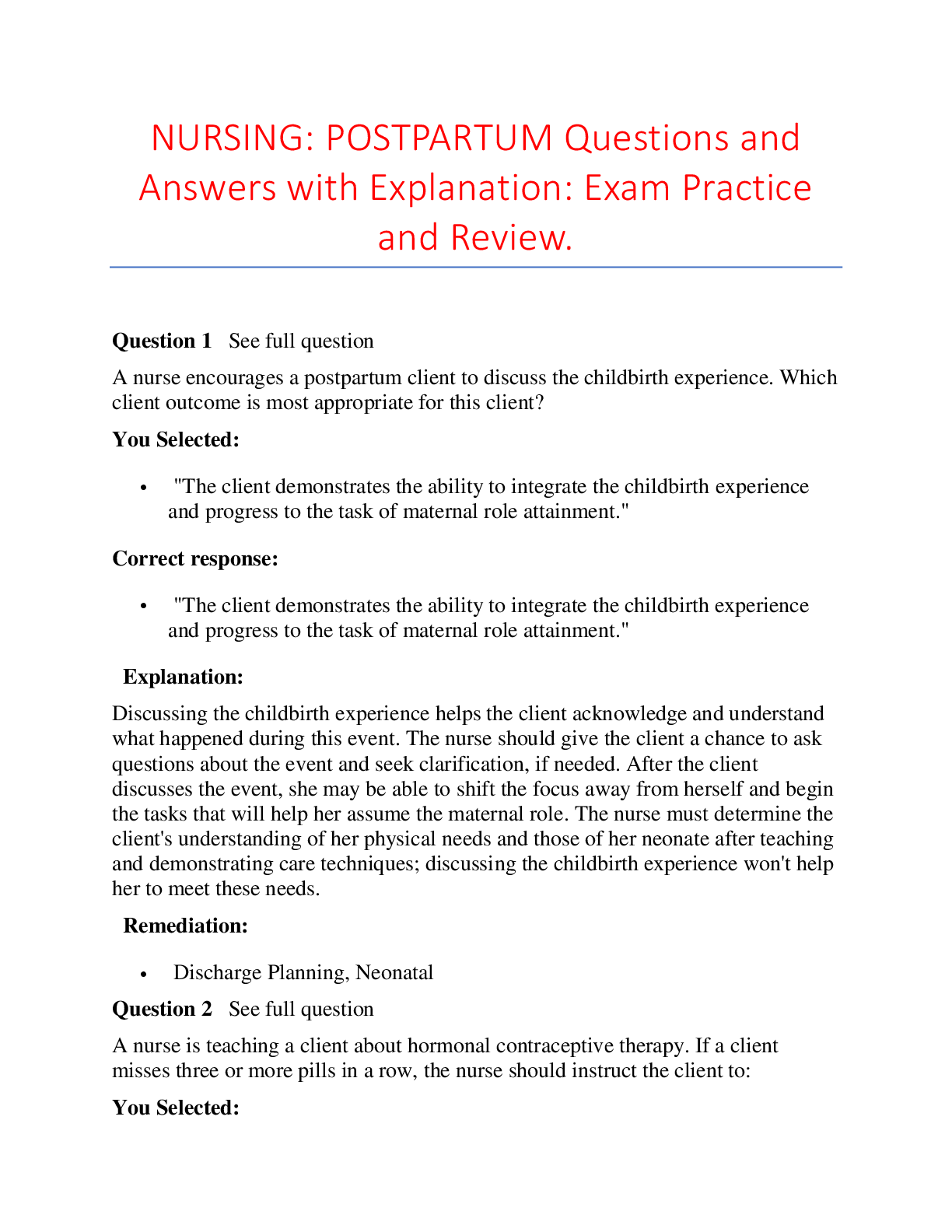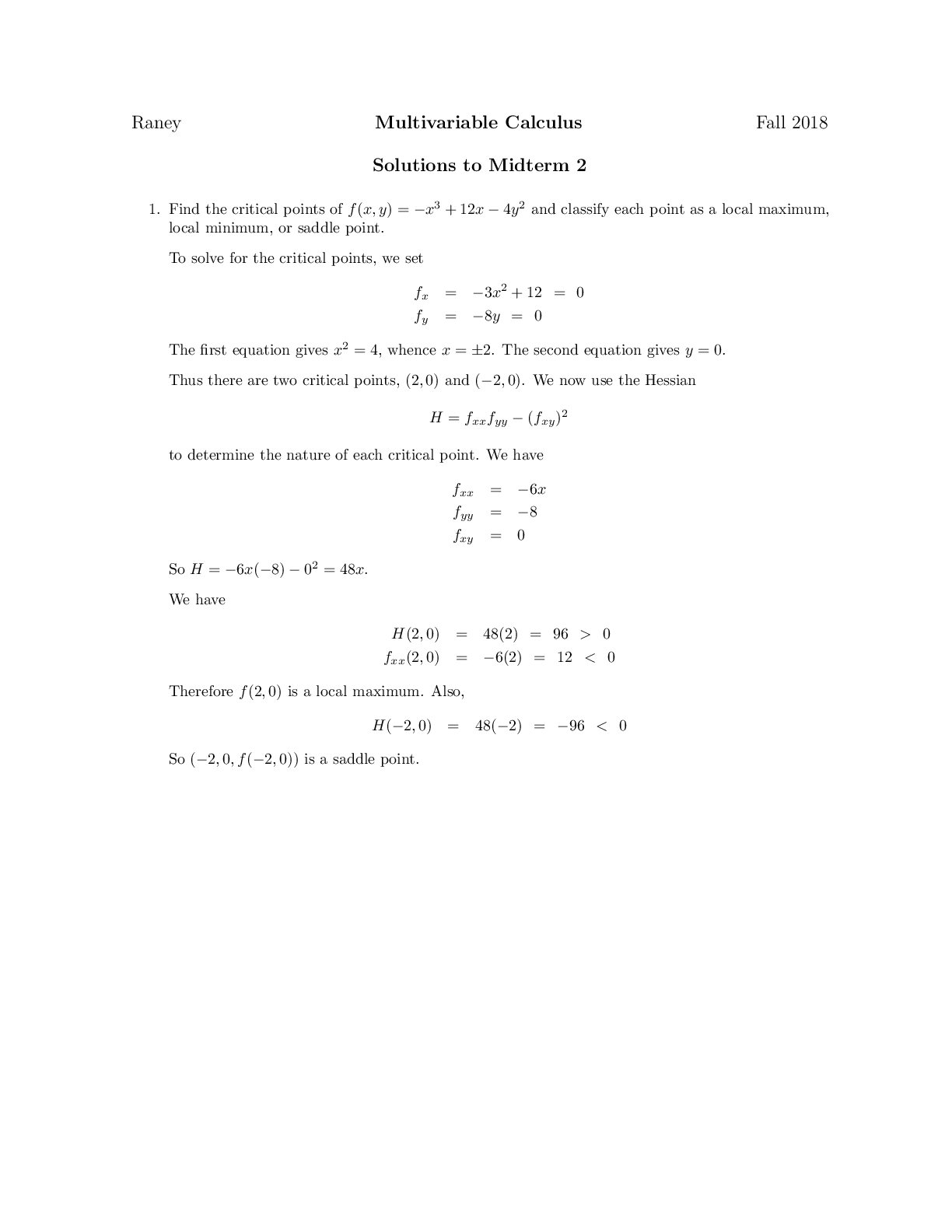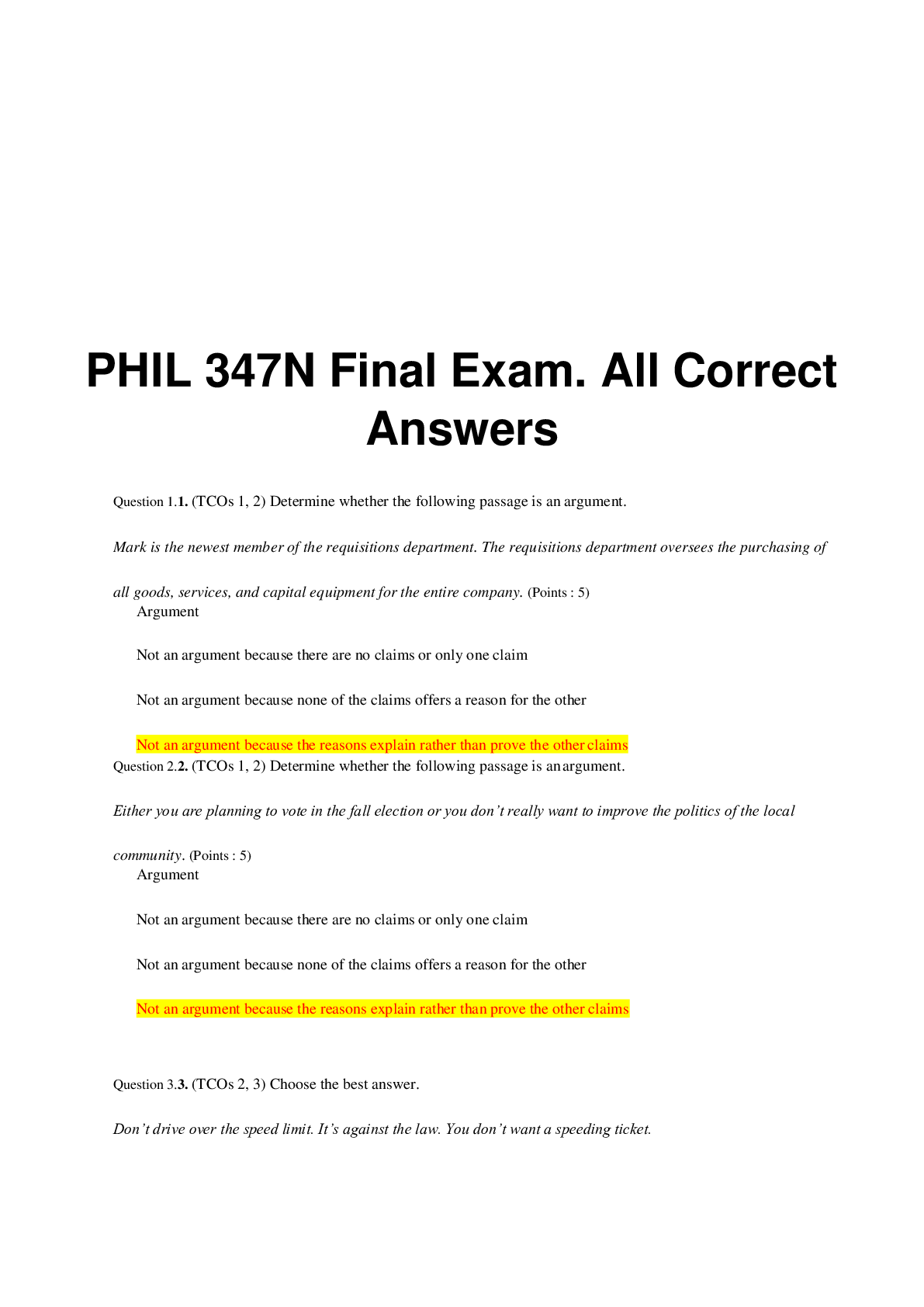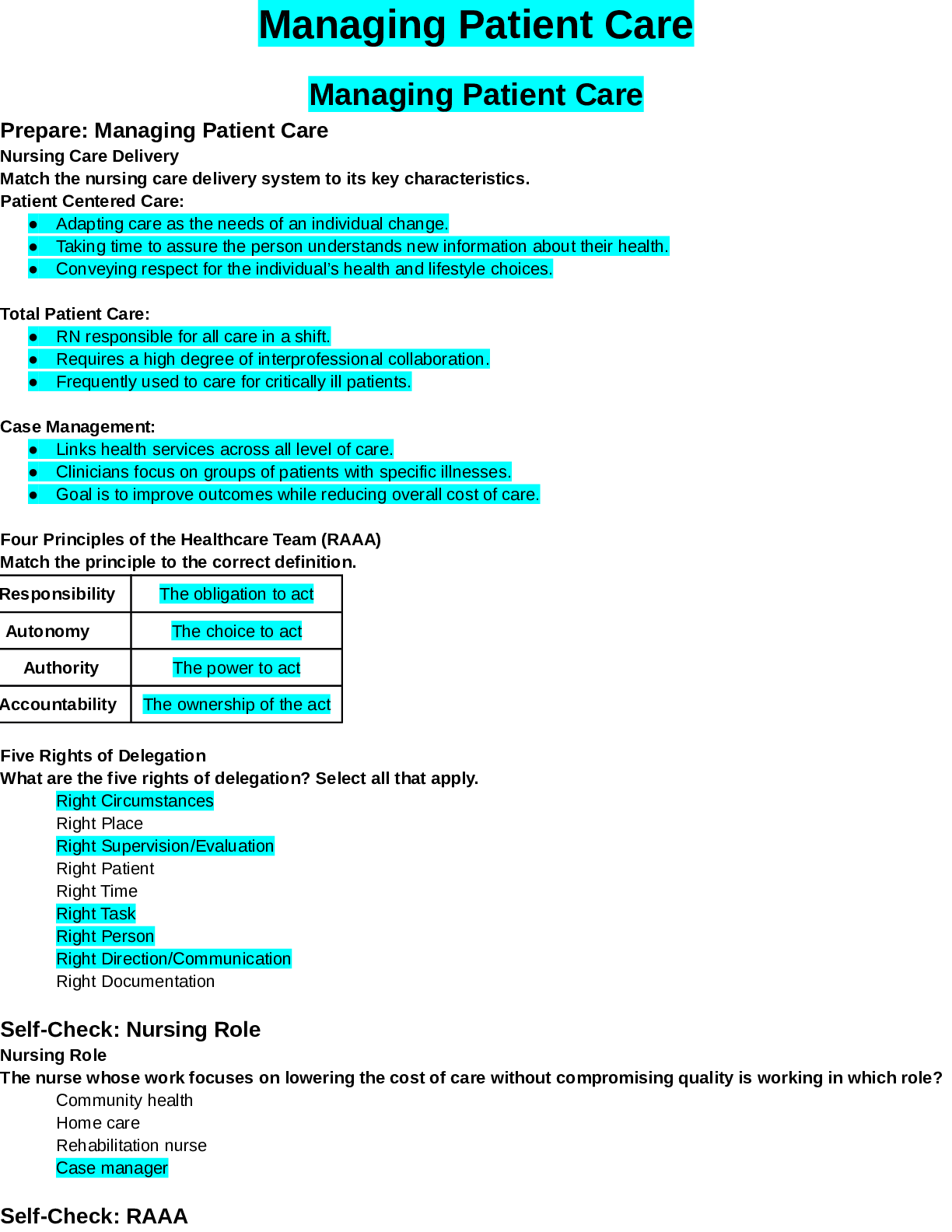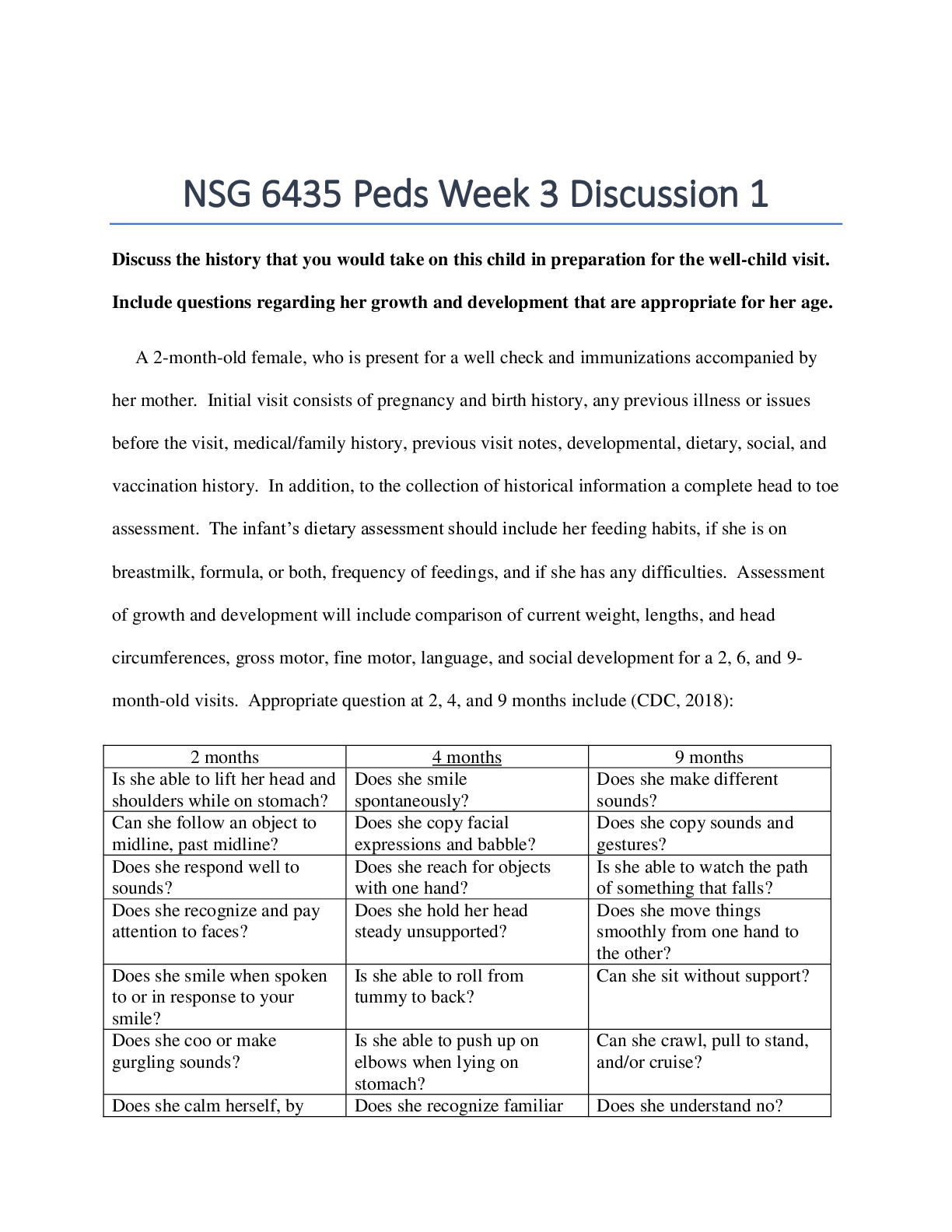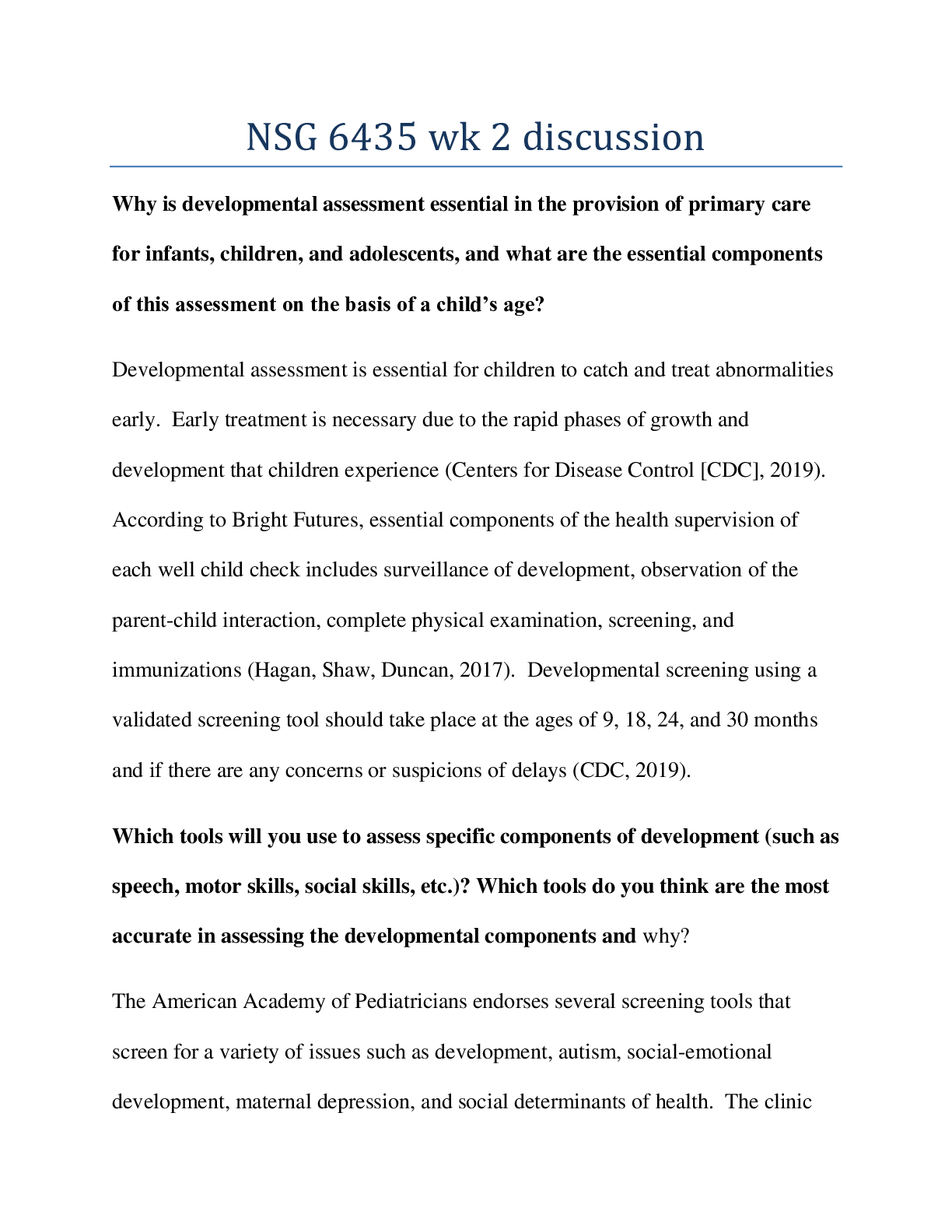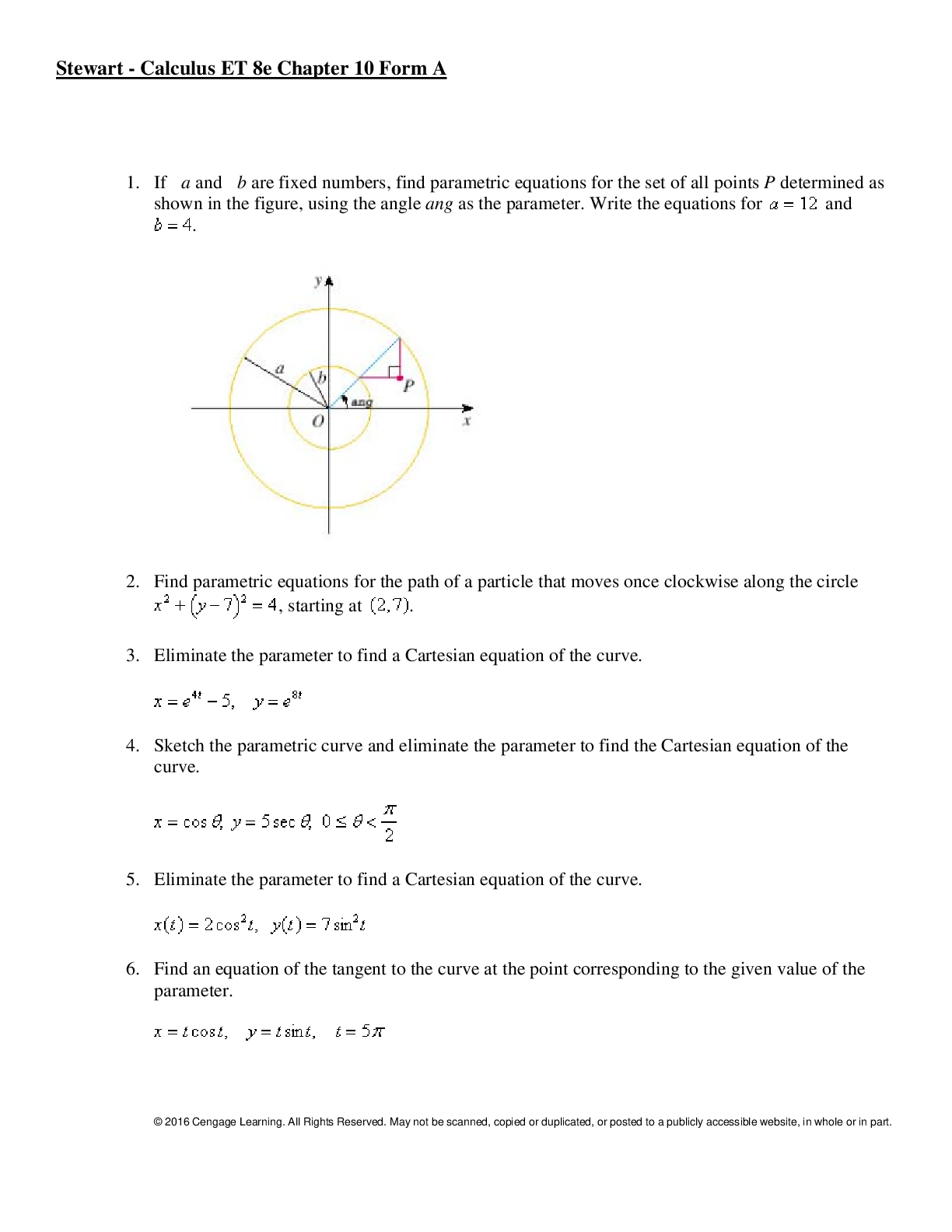Financial Accounting > QUESTIONS & ANSWERS > ACCOUNTING 305exam+3+practice Chapter 10. All Answers Correct (All)
ACCOUNTING 305exam+3+practice Chapter 10. All Answers Correct
Document Content and Description Below
ACCOUNTING 305exam+3+practice Chapter 10 1. The cost of land does not include a. costs of grading, filling, draining, and clearing. b. costs of removing old buildings. c. costs of improvements ... with limited lives. d. special assessments. c 2. The cost of land typically includes the purchase price and all of the following costs except a. grading, filling, draining, and clearing costs. b. street lights, sewers, and drainage systems cost. c. private driveways and parking lots. d. assumption of any liens or mortgages on the property. c 3. If a corporation purchases land and building and subsequently tears down the building and uses the property as a parking lot, the proper accounting treatment of the cost of the building would depend on a. the significance of the cost allocated to the building in relation to the combined cost of the land and building. b. the length of time for which the building was held prior to its demolition. c. the contemplated future use of the parking lot. d. the intention of management for the property when the building was acquired. d 4. Assets that qualify for interest cost capitalization include a. assets under construction for a company's own use. b. assets that are ready for their intended use in the earnings of the company. c. assets that are not currently being used because of excess capacity. d. All of these assets qualify for interest cost capitalization. a 5. When computing the amount of interest cost to be capitalized, the concept of "avoidable interest" refers to a. the total interest cost actually incurred. b. a cost of capital charge for stockholders' equity. c. that portion of total interest cost which would not have been incurred if expenditures for asset construction had not been made. d. that portion of weighted-average accumulated expenditures on which no interest cost was incurred. c 6. The period of time during which interest must be capitalized ends when a. the asset is substantially complete and ready for its intended use. b. no further interest cost is being incurred. c. the asset is fully depreciated. d. the activities that are necessary to get the asset ready for its intended use have begun. a 7. Accounting recognition should be given to some or all of the gain realized on a nonmonetary exchange of plant assets except when the exchange has a. no commercial substance and additional cash is paid. b. no commercial substance and additional cash is received. c. commercial substance and additional cash is paid. d. commercial substance and additional cash is received. A 8. For a nonmonetary exchange of plant assets, accounting recognition should not be given to a. a loss when the exchange has no commercial substance. b. a gain when the exchange has commercial substance. c. part of a gain when the exchange has no commercial substance and cash is paid (cash paid/received is less than 25% of the fair value of the exchange). d. part of a gain when the exchange has no commercial substance and cash is received (cash paid or received is less than 25% of the fair value of the exchange). c 9. Which of the following is not a capital expenditure? a. Repairs that maintain an asset in operating condition b. An addition c. A betterment d. A replacement a Use the following information for questions 10 and 11. Wilson Co. purchased land as a factory site for $900,000. Wilson paid $80,000 to tear down two buildings on the land. Salvage was sold for $5,400. Legal fees of $3,480 were paid for title investigation and making the purchase. Architect's fees were $31,200. Title insurance cost $2,400, and liability insurance during construction cost $2,600. Excavation cost $10,440. The contractor was paid $2,800,000. An assessment made by the city for pavement was $6,400. Interest costs during construction were $170,000. 10. The cost of the land that should be recorded by Wilson Co. is a. $980,480. b. $986,880. c. $989,880. d. $996,280. B 900000+80000-5400+3480+2400+6400=986880 64. The cost of the building that should be recorded by Wilson Co. is a. $2,803,800. b. $2, 804,840. c. $2, 813,200. d. $3,014,240. D 31200+2600+10440+2800+170000=3014240 11. Mendenhall Corporation constructed a building at a cost of $10,000,000. Weighted-average accumulated expenditures were $4,000,000, actual interest was $400,000, and avoidable interest was $200,000. If the salvage value is $800,000, and the useful life is 40 years, depreciation expense for the first full year using the straight-line method is a. $235,000. b. $240,000. c. $255,000. d. $335,000. a [($10,000,000 + $200,000) – $800,000] ÷ 40 = $235,000. 12. Messersmith Company is constructing a building. Construction began in 2014 and the building was completed 12/31/14. Messersmith made payments to the construction company of $2,000,000 on 7/1, $4,200,000 on 9/1, and $4,000,000 on 12/31. Weighted-average accumulated expenditures were a. $2,050,000. b. $2,400,000. c. $6,200,000. d. $10,200,000. b ($2,000,000 × 6/12) + ($4,200,000 × 4/12) = $2,400,000. 13. Huffman Corporation constructed a building at a cost of $20,000,000. Weighted-average accumulated expenditures were $8,000,000, actual interest was $800,000, and avoidable interest was $400,000. If the salvage value is $1,600,000, and the useful life is 40 years, depreciation expense for the first full year using the straight-line method is a. $470,000. b. $490,000. c. $510,000. d. $670,000. a [($20,000,000 + $400,000) – $1,600,000] ÷ 40 = $470,000. 14. Gutierrez Company is constructing a building. Construction began in 2014 and the building was completed 12/31/14. Gutierrez made payments to the construction company of $2,500,000 on 7/1, $5,500,000 on 9/1, and $5,000,000 on 12/31. Weighted-average accumulated expenditures were a. $2,625,000. b. $3,083,333. c. $8,000,000. d. $13,000,000. b ($2,500,000 × 6/12) + ($5,500,000 × 4/12) = $3,083,333. 15. On May 1, 2014, Goodman Company began construction of a building. Expenditures of $360,000 were incurred monthly for 5 months beginning on May 1. The building was completed and ready for occupancy on September 1, 2014. For the purpose of determining the amount of interest cost to be capitalized, the weighted-average accumulated expenditures on the building during 2014 were a. $300,000. b. $360,000. c. $1,440,000. d. $1,800,000. a ($360,000 × 4/12) + ($360,000 × 3/12) + ($360,000 × 2/12) + ($360,000 × 1/12) = $300,000. 16. During 2014, Kimmel Co. incurred weighted-average accumulated expenditures of $800,000 during construction of assets that qualified for capitalization of interest. The only debt outstanding during 2014 was a $1,000,000, 10%, 5-year note payable dated January 1, 2012. What is the amount of interest that should be capitalized by Kimmel during 2014? a. $0. b. $20,000. c. $80,000. d. $100,000. c $800,000 × .10 = $80,000. 17. On March 1, Felt Co. began construction of a small building. Payments of $320,000 were made monthly for three months beginning March 1. The building was completed and ready for occupancy on June 1. In determining the amount of interest cost to be capitalized, the weighted-average accumulated expenditures are a. $80,000. b. $160,000. c. $320,000. d. $640,000. b $320,000 (3/12 + 2/12 + 1/12) = $160,000. 18. On March 1, Imhoff Co. began construction of a small building. Payments of $400,000 were made monthly for four months beginning March 1. The building was completed and ready for occupancy on June 1. In determining the amount of interest cost to be capitalized, the weighted-average accumulated expenditures are a. $200,000. b. $400,000. c. $800,000. d. $1,600,000. a $400,000 (3/12 + 2/12 + 1/12) = $200,000 25. Hardin Company received $80,000 in cash and a used computer with a fair value of $240,000 from Page Corporation for Hardin Company's existing computer having a fair value of $320,000 and an undepreciated cost of $300,000 recorded on its books. The transaction has commercial substance. How much gain should Hardin recognize on this exchange, and at what amount should the acquired computer be recorded, respectively? a. $0 and $220,000 b. $1,537 and $221,537 c. $20,000 and $240,000 d. $80,000 and $300,000 c $320,000 – $300,000 = $20,000; $240,000 (fair value). Use the following information to answer questions 26 & 27. Jamison Company purchased the assets of Booker Company at an auction for $4,200,000. An independent appraisal of the fair value of the assets is listed below: Land $1,425,000 Building 2,100,000 Equipment 1,575,000 Trucks 2,550,000 26. Assuming that specific identification costs are impracticable and that Jamison allocates the purchase price on the basis of the relative fair values, what amount would be allocated to the Trucks? a. $1,400,000 b. $2,100,000 c. $2,520,000 d. $2,550,000 a [$2,550,000 ÷ ($1,425,000 + $2,100,000 + $1,575,000 + $2,550,000)] × $4,200,000 = $1,400,000. 27. Assuming that specific identification costs are impracticable and that Jamison allocates the purchase price on the basis of the relative fair values, what amount would be allocated to the Building? a. $1,589,190 b. $2,100,000 c. $3,825,000 d. $1,152,941 d [$2,100,000 ÷ ($1,425,000 + $2,100,000 + $1,575,000 + $2,550,000)] × $4,200,000 = $1,152,941. 28. On April 1, Mooney Corporation purchased for $1,624,500 a tract of land on which a warehouse and office building was located. The following data were collected concerning the property: Current Assessed Valuation Vendor’s Original Cost Land $600,000 $560,000 Warehouse 400,000 360,000 Office building 800,000 680,000 $1,800,000 $1,600,000 What are the appropriate amounts that Mooney should record for the land, warehouse, and office building, respectively? a. Land, $560,000; warehouse, $360,000; office building, $680,000. b. Land, $600,000; warehouse, $400,000; office building, $800,000. c. Land, $568,575; warehouse, $365,513; office building, $345,206. d. Land, $541,500; warehouse, $361,000; office building, $722,000. d Land: 60/180 × $1,624,500 = $541,500. Warehouse: 40/180 × $1,624,500 = $361,000. Office Building: 80/180 × $1,624,500 = $722,000. 30. On December 1, 2014, Kelso Company acquired new equipment in exchange for old equipment that it had acquired in 2011. The old equipment was purchased for $140,000 and had a book value of $53,200. On the date of the exchange, the old equipment had a fair value of $56,000. In addition, Kelso paid $182,000 cash for the new equipment, which had a list price of $252,000. The exchange lacked commercial substance. At what amount should Kelso record the new equipment for financial accounting purposes? a. $182,000. b. $235,200. c. $238,000. d. $252,000. b $56,000 + $182,000 -2800 31. Timmons Company traded machinery with a book value of $360,000 and a fair value of $600,000. It received in exchange from Lewis Company a machine with a fair value of $540,000 and cash of $60,000. Lewis’s machine has a book value of $570,000. What amount of gain should Timmons recognize on the exchange (assuming lack of commercial substance)? a. $ -0- b. $24,000 c. $60,000 d. $240,000 b ($600,000 – $360,000) × [$60,000 ÷ ($60,000 + $540,000)] = $24,000. 32. Lewis Company traded machinery with a book value of $760,000 and a fair value of $720,000. It received in exchange from Timmons Company a machine with a fair value of $800,000. Lewis also paid cash of $80,000 in the exchange. Timmons’s machine has a book value of $760,000. What amount of gain or loss should Lewis recognize on the exchange (assuming lack of commercial substance)? a. $80,000 gain b. $ -0-. c. $4,000 loss d. $40,000 loss d $720,000 – $760,000 = ($40,000). Chapter 11 1. If an industrial firm uses the units-of-production method for computing depreciation on its only plant asset, factory machinery, the credit to accumulated depreciation from period to period during the life of the firm will a. be constant. b. vary with unit sales. c. vary with sales revenue. d. vary with production. d 2. Use of the double-declining balance method a. results in a decreasing charge to depreciation expense. b. means salvage value is not deducted in computing the depreciation base. c. means the book value should not be reduced below salvage value. d. all of these answers are correct. d 3. Use of the sum-of-the-years'-digits method a. results in salvage value being ignored. b. means the denominator is the years remaining at the beginning of the year. c. means the book value should not be reduced below salvage value. d. all of these answers are correct. c 4. Depletion expense a. is usually part of cost of goods sold. b. includes tangible equipment costs in the depletion base. c. excludes intangible development costs from the depletion base. d. excludes restoration costs from the depletion base. a 5. The most common method of recording depletion for accounting purposes is the a. percentage depletion method. b. decreasing charge method. c. straight-line method. d. units-of-production method. D 6. Henry Company purchased a depreciable asset for $240,000. The estimated salvage value is $22,000, and the estimated useful life is 10 years. The straight-line method will be used for depreciation. What is the depreciation base of this asset? a. $22,000 b. $24,000 c. $218,000 d. $240,000 c $240,000 – $22,000 = $218,000. 7. Slotkin Products purchased a machine for $39,000 on July 1, 2014. The company intends to depreciate it over 8 years using the double-declining balance method. Salvage value is $3,000. Depreciation for 2014 is a. $19,500 b. $4,875 c. $8,531 d. $9,000 7. b ($39,000 – 0) × .25 × 6/12 = $4,875. 8. Slotkin Products purchased a machine for $39,000 on July 1, 2014. The company intends to depreciate it over 8 years using the double-declining balance method. Salvage value is $3,000. Depreciation for 2015 to the closest dollar is a. $19,500 b. $4,875 c. $8,531 d. $7,500 c ($39,000 – 0) × .25 × 6/12 = $4,875; ($39,000 – $4,875) × .25 = $8,531.25 (rounded to $8,531). 9. Grover Corporation purchased a truck at the beginning of 2014 for $93,600. The truck is estimated to have a salvage value of $3,600 and a useful life of 120,000 miles. It was driven 21,000 miles in 2014 and 29,000 miles in 2015. What is the depreciation expense for 2014? a. $17,010 b. $15,750 c. $21,750 d. $37,500 b ($93,600 – $3,600) ÷ 120,000 = $0.75; $0.75 × 21,000 = $15,750. 10. Grover Corporation purchased a truck at the beginning of 2014 for $93,600. The truck is estimated to have a salvage value of $3,600 and a useful life of 120,000 miles. It was driven 21,000 miles in 2014 and 29,000 miles in 2015. What is the depreciation expense for 2015? a. $23,490 b. $6,000 c. $21,750 d. $37,500 c ($93,600 – $3,600) ÷ 120,000 = $0.75; $0.75 × 29,000 = $21,750. 11. Carson Company purchased a depreciable asset for $280,000. The estimated salvage value is $14,000, and the estimated useful life is 10,000 hours. Carson used the asset for 1,500 hours in the current year. The activity method will be used for depreciation. What is the depreciation expense on this asset? a. $26,600 b. $39,900 c. $44,100 d. $266,000 b [$280,000 – $14,000) ÷ 10,000] × 1,500 = $39,900. 12. Jasmine Company purchased a depreciable asset for $225,000. The estimated salvage value is $15,000, and the estimated useful life is 8 years. The double-declining balance method will be used for depreciation. What is the depreciation expense for the second year on this asset? a. $26,250 b. $39,375 c. $42,188 d. $56,250 c $225,000 × [(1 ÷ 8) × 2] = $56,250 ($225,000 – $56,250) × [(1 ÷ 8) × 2] = $42,188. 13. Endeavor Company purchased a depreciable asset for $800,000. The estimated salvage value is $40,000, and the estimated useful life is 10,000 hours. Endeavor used the asset for 1,100 hours in the current year. The activity method will be used for depreciation. What is the depreciation expense on this asset? a. $76,000 b. $83,600 c. $88,000 d. $760,000 b [($800,000 – $40,000) ÷ 10,000] × 1,100 = $83,600. 14. Halltown Company purchased a depreciable asset for $450,000. The estimated salvage value is $30,000, and the estimated useful life is 8 years. The double-declining balance method will be used for depreciation. What is the depreciation expense for the second year on this asset? a. $52,500 b. $78,750 c. $84,375 d. $112,500 c $450,000 × [(1 ÷ 8) × 2] = $112,500 ($450,000 – $112,500) × [(1 ÷ 8) × 2] = $84,375. 15. On January 1, 2014, Garden Company purchased a new machine for $2,800,000. The new machine has an estimated useful life of nine years and the salvage value was estimated to be $100,000. Depreciation was computed on the sum-of-the-years'-digits method. What amount should be shown in Garden's balance sheet at December 31, 2015, net of accumulated depreciation, for this machine? a. $2,260,000 b. $1,780,000 c. $1,742,221 d. $1,659,000 b $2,800,000 – [($2,800,000 – $100,000) × (9/45 + 8/45)] = $1,780,000. (for two years) 16. On January 1, 2008, Forrest Company purchased equipment at a cost of $130,000. The equipment was estimated to have a salvage value of $4,000 and it is being depreciated over eight years under the sum-of-the-years'-digits method. What should be the charge for depreciation of this equipment for the year ended December 31, 2015? a. $3,500 b. $3,611 c. $16,250 d. $15,750 a ($130,000 – $4,000) × 1/36 = $3,500.(last year) 17. On September 19, 2014, Markham Co. purchased machinery for $285,000. Salvage value was estimated to be $15,000. The machinery will be depreciated over eight years using the sum-of-the-years'-digits method. If depreciation is computed on the basis of the nearest full month, Markham should record depreciation expense for 2015 on this machinery of a. $61,354. b. $58,267. c. $58,125. d. $52,500. c ($270,000 × 8/36 × 9/12) + ($270,000 × 7/36 × 3/12) = $58,125. 18. In January, 2014, Yager Corporation purchased a mineral mine for $5,100,000 with removable ore estimated by geological surveys at 2,000,000 tons. The property has an estimated value of $300,000 after the ore has been extracted. The company incurred $1,500,000 of development costs preparing the mine for production. During 2014, 500,000 tons were removed and 400,000 tons were sold. What is the amount of depletion for 2014? a. $960,000 b. $1,200,000 c. $1,575,000 d. $1,680,000 c [($5,100,000 – $300,000 + $1,500,000) ÷ 2,000,000] × 400,000 = $1,575,000. 19. During 2014, Corporation acquired a mineral mine for $4,000,000 of which $400,000 was ascribed to land value after the mineral has been removed. Geological surveys have indicated that 10 million units of the mineral could be extracted. During 2014, 1,800,000 units were extracted. What is the amount of depletion for 2014? a. $400,000. b. $540,000. c. $360,000. d. $648,000. D [($4,000,000 – $400,000) ÷ 10,000,000] × 1,500,000 20. In March, 2014, Mallory Mines Co. purchased a coal mine for $8,000,000. Removable coal is estimated at 1,500,000 tons. Mallory is required to restore the land at an estimated cost of $960,000, and the land should have a value of $840,000. The company incurred $2,000,000 of development costs preparing the mine for production. During 2014, 450,000 tons were removed and 300,000 tons were sold. The total amount of depletion that Mallory should record for 2014 is a. $1,832,000. b. $2,024,000. c. $2,748,000. d. $3,036,000. d [($8,000,000 + $960,000 – $840,000 + $2,000,000) ÷ 1,500,000] × 450,000 = $3,036,000. Chapter 12 1. Which characteristic is not possessed by intangible assets? a. Physical existence. b. Long-lived. c. Result in future benefits. d. Expensed over current and/or future years. a 2. Costs incurred internally to create intangibles are a. capitalized. b. capitalized if they have an indefinite life. c. expensed as incurred. d. expensed only if they have a limited life. c 3. Which of the following costs incurred internally to create an intangible asset is generally expensed? a. Research and development costs. b. Filing costs. c. Legal costs. d. All of these answer choices are correct. a 4. Which of the following methods of amortization is normally used for intangible assets? a. Sum-of-the-years'-digits b. Straight-line c. Units of production d. Double-declining-balance b 5. Which intangible assets are amortized? Limited-Life Indefinite-Life a. Yes Yes b. Yes No c. No Yes d. No No b 6. The cost of successfully defending a patent suit should be a. charged off in the current period. b. amortized over the legal life of the purchased patent. c. added to factory overhead and allocated to production of the product. d. amortized over the remaining estimated useful life of the patent. d 7. Broadway Corporation was granted a patent on a product on January 1, 2004. To protect its patent, the corporation purchased on January 1, 2015 a patent on a competing product which was originally issued on January 10, 2011. Because of its unique plant, Broadway Corporation does not feel the competing patent can be used in producing the product. The cost of the competing patent should be a. amortized over a maximum period of 20 years. b. amortized over a maximum period of 16 years. c. amortized over a maximum period of 9 years. d. expensed in 2015. c 8. Wriglee, Inc. went to court this year and successfully defended its patent from infringement by a competitor. The cost of this defense should be charged to a. patents and amortized over the legal life of the patent. b. legal fees and amortized over 5 years or less. c. expenses of the period. d. patents and amortized over the remaining useful life of the patent. d 9. Which of the following is a contract-related intangible assts? a. Trademark b. Copyright c. Franchise d. Patent c 10. The recoverability test is used to determine any impairment loss on which of the following types of intangible assets? a. Indefinite life intangibles other than goodwill. b. Indefinite life intangibles. c. Goodwill. d. Limited life intangibles. d 11. Buerhle Company needs to determine if its indefinite-life intangibles other than goodwill have been impaired and should be reduced or written off on its balance sheet. The impairment test(s) to be used is (are) Recoverability Test Fair Value Test a. Yes Yes b. Yes No c No Yes d. No No c 12. Which of the following costs should be capitalized in the year incurred? a. Research and development costs. b. Costs to internally generate goodwill. c. Organizational costs. d. Costs to successfully defend a patent. d 13. Research and development costs a. are intangible assets. b. may result in the development of a patent. c. are easily identified with specific projects. d. All of these answer choices are correct. b 14. Dotel Company’s 12/31/15 balance sheet reports assets of $9,000,000 and liabilities of $3,750,000. All of Dotel’s assets’ book values approximate their fair value, except for land, which has a fair value that is $600,000 greater than its book value. On 12/31/15, Egbert Corporation paid $9,150,000 to acquire Dotel. What amount of goodwill should Egbert record as a result of this purchase? a. $ -0- b. $ 150,000 c. $3,300,000 d. $3,900,000 c ($9,000,000 + $600,000) – $3,750,000 = $5,850,000. $9,150,000 – $5,850,000 = $3,300,000. 15. Floyd Company purchases Haeger Company for $1,600,000 cash on January 1, 2015. The book value of Haeger Company’s net assets, as reflected on its December 31, 2014 balance sheet is $1,240,000. An analysis by Floyd on December 31, 2012 indicates that the fair value of Haeger’s tangible assets exceeded the book value by $120,000, and the fair value of identifiable intangible assets exceeded book value by $90,000. How much goodwill should be recognized by Floyd Company when recording the purchase of Haeger Company? a. $ -0- b. $360,000 c. $240,000 d. $150,000 d $1,240,000 + $120,000 + $90,000 = $1,450,000. $1,600,000 – $1,450,000 = $150,000. 16. Dennis Company purchases Miles Company for $4,200,000 cash on January 1, 2015. The book value of Miles Company's net assets reported on its December 31, 2014 financial statement was $3,800,000. An analysis indicated that the fair value of Miles's tangible assets exceeded the book value by $600,000, and the fair value of identifiable intangible assets exceeded book value by $320,000. What amount of gain or goodwill is recognized by Dennis? a. $920,000 gain. b. $400,000 goodwill. c. $520,000 gain. d. $520,000 goodwill. c $3,800,000 + $600,000 + $320,000 = $4,720,000; $4,720,000 – $4,200,000 = $520,000. 17. Twilight Corporation acquired End-of-the-World Products on January 1, 2014 for $6,400,000, and recorded goodwill of $1,200,000 as a result of that purchase. At December 31, 2015, the End-of-the-World Products Division had a fair value of $5,440,000. The net identifiable assets of the Division (excluding goodwill) had a fair value of $4,640,000 at that time. What amount of loss on impairment of goodwill should Twilight record in 2015? a. $ -0- b. $400,000 c. $560,000 d. $960,000 b $5,440,000 – $4,640,000 = $800,000 $1,200,000 – $800,000 = $400,000. 18. Jenks Corporation acquired Linebrink Products on January 1, 2015 for $8,000,000, and recorded goodwill of $1,500,000 as a result of that purchase. At December 31, 2015, Linebrink Products had a fair value of $6,800,000. The net identifiable assets of the Linebrink (excluding goodwill) had a fair value of $5,800,000 at that time. What amount of loss on impairment of goodwill should Jenks record in 2015? a. $ -0- b. $500,000 c. $700,000 d. $1,200,000 b $6,800,000 – $5,800,000 = $1,000,000 $1,500,000 – $1,000,000 = $500,000. 19. Leeper Corporation incurred the following costs in 2015: Acquisition of R&D equipment with a useful life of 4 years in R&D projects $900,000 Cost of making minor modifications to an existing product 140,000 Advertising expense to introduce a new product 700,000 Engineering costs incurred to advance a product to full production stage 750,000 What amount should Leeper record as research & development expense in 2015? a. $ 975,000 b. $1,040,000 c. $1,450,000 d. $1,740,000 a ($900,000 ÷ 4) + $750,000 = $975,000. 20. Platteville Corporation has the following account balances at 12/31/15: Amortization expense $ 20,000 Goodwill 280,000 Patent, net of $60,000 amortization 140,000 What amount should Platteville report for intangible assets on the 12/31/12 balance sheet? a. $140,000 b. $200,000 c. $420,000 d. $440,000 c $280,000 + $140,000 = $420,000. [Show More]
Last updated: 2 years ago
Preview 1 out of 14 pages

Buy this document to get the full access instantly
Instant Download Access after purchase
Buy NowInstant download
We Accept:

Reviews( 0 )
$13.00
Can't find what you want? Try our AI powered Search
Document information
Connected school, study & course
About the document
Uploaded On
Dec 05, 2020
Number of pages
14
Written in
Additional information
This document has been written for:
Uploaded
Dec 05, 2020
Downloads
0
Views
76

